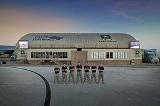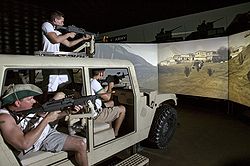
Virtual Army Experience
Encyclopedia

Zombie Studios
Zombie Studios is an American independent video game developer of console, PC, mobile and web-based games. It was formed in 1994 by Joanna Alexander and Mark Long, formerly of the Sarnoff Research Center. Alexander and Long founded Zombie after they completed the design of a virtual reality game...
. The interactive exhibit brings the Army’s popular computer game, America’s Army: Special Forces (Overmatch), to a life-size, networked environment to provide visitors with a limited test drive of soldiering. Utilizing a complex set-up of computers, LAN based scenarios, motion simulators, and videos, the VAE is a massive display of technological invention. The VAE was greeted with enthusiasm by the public and the experiential marketing community for its innovative design, use of advanced measurement technology, and its ability to engage visitors through an immersive, entertaining and educational experience. The Army's use of storytelling, and virtual-reality techniques compares favorably with advanced experiences at several theme parks. The dual use of the virtual environment with tracking technology is a potent combination that commercial marketers could learn from, say experts, especially those marketers who target young adults.
The VAE is managed by the Army’s Office of Economic and Manpower Analysis (OEMA) at the United States Military Academy, West Point. OEMA director Colonel Casey Wardynski is the originator of the Army Game Project. The Army spent about $9 million building four versions of the Virtual Army Experience, Col. Wardynski said. He recognized that the appetite of young Americans for electronic entertainment was growing faster than their interest in television and other forms of traditional media. According to Nielsen, three out of four residences with males under 34 have a game system. Col. Wardynski envisioned "using computer game technology to provide the public a virtual soldier experience that was engaging, informative and entertaining."
Overview

The VAE can be delivered in its full scale rendition, or may be broken down into two smaller versions, enabling it to travel to a diverse range of events simultaneously. In all, there are four traveling packages that offer indoor/outdoor experiences and allow the VAE to travel year round across the United States. In two years, the VAE has traveled to over 40 states, at a wide variety of locales including NASCAR races, Six Flags Amusement Parks, State Fairs, Spring Break festivities, Music Festivals, Air Shows and Urban Expos. It cost $9.8 million a year to operate the exhibits.
Exhibit Details

The Experience

Upon completion, participants move to the After Action Review area where they receive a debriefing on their performances. Real soldiers and Ignited employees review their team’s performance during the mission and highlight areas such as teamwork or communication where visitors could have performed better. Team Leaders also emphasize the role Army values, such as duty, respect and honor, play in mission accomplishment.
To add an air authenticity to the experience, visitors at select locations are introduced to a soldier who has distinguished himself in combat and earned citations for bravery and valor. This soldier briefly shares his or her experiences with visitors, after which visitors watch a short video that re-enacts the soldier’s heroic acts in combat. In some cases, visitors applaud and want their photo taken with these soldiers.
According to Sergeant Tommy Rieman, “people have a general perception about the army before they enter (the VAE) and when they leave they have a greater appreciation.”
Some veterans complain that the experience is misleading - that it trivializes their real combat experience. Critics say the Army's videogames don't give an accurate portrayal of war and Army life. "War is not a game," said Sholom Keller, national membership coordinator for Iraq Veterans Against the War, who said he served in the Army from 2001 to 2005 and fought in Afghanistan and Iraq.
The American Civil Liberties Union (ACLU) has found that Army use of the game, and its recruiting practice in general, violate international law. In May, the ACLU published a report that found the armed services "regularly target children under 17 for military recruitment. Department of Defense instructions to its recruiters and the US military's collection of information of hundreds of thousands of 16-year-olds, and the military training corps for children as young as 11, all reveal that students are targeted for recruitment as early as possible. By exposing children under 17 to military recruitment, the United States military violates the Optional Protocol." The Optional Protocol on the Involvement of Children in Armed Conflict, ratified by the Senate in December 2002, protects the rights of children under 16 from military recruitment and deployment to war.
Prior to exiting, visitors receive a free copy of the America’s Army PC game so, if desired, they can join the game's online community and continue to explore the Army at home by playing the game.
Private corporations like Ubisoft reap handsome profits from the Army's project to train and recruit children. Military game developers are very open about this role, as Colonel Wardynski proudly proclaims, "We want kids to come into the Army and feel like they've already been there."
In response to criticism about the authenticity of the experience, Col. Wardynski compares the VAE to other Army branding efforts: “There is only so much the Virtual Army Experience can do to depict Army life, and it does a better job than a 30-second commercial.”
Academic References
- Allen, Robertson. 2009. "The Army Rolls Through Indianapolis: Fieldwork at the Virtual Army Experience." Transformative Works and Cultures 2.
VAE General Facts
- Attracted over 150,000 participants across the United States through March, 2009.
- Able to host up to 2,300 participants in a typical day.
- Attended more than 100 events including air shows, music festivals, amusement parks, Spring Break, NASCAR and NHRA races and urban expos thru March, 2009.
- Houses more than 70 flat screen panels and more than 5 miles (8 km) of data cable.
- Requires more than 75 computers and 260 gigs of processing power to run the experience.
- Is covered by an inflatable dome weighing over 5,400 pounds
- Scenarios presented within the VAE Mission Simulator are based on the America’s Army game which is rated T for Teen by Entertainment Software Rating Board standards for a teen rated game. As with the PC game, VAE participants operate under rules of engagement and laws of war in order to achieve mission success.
Accolades
The VAE has earned several awards and been recognized by various industry experts:- Event Design Magazine – 2007 Best Outdoor Consumer Experience - Bronze award
- Guinness World Records - World’s Largest Virtual Army - Gamers Edition 2009
- Cover story in AdWeek Magazine, November 2007
- Event Marketer Magazine, October 17, 2007 - “Best Army effort of 2007? The Virtual Army Experience, currently on the road hitting stops along the NASCAR circuit and beyond, is taking outdoor event design to the next level with each and every visitor. Four double-expandable tractor trailers, five full-sized Humvee battle simulators, and three miles of computer and electronic cables, all under an inflatable dome? Yeah, makes quite a statement.”
- Event Solution Magazine, February 2008 - “Enter the Virtual Army Experience, and you enter a world catered to every nuance of the Gen Y psyche.”

